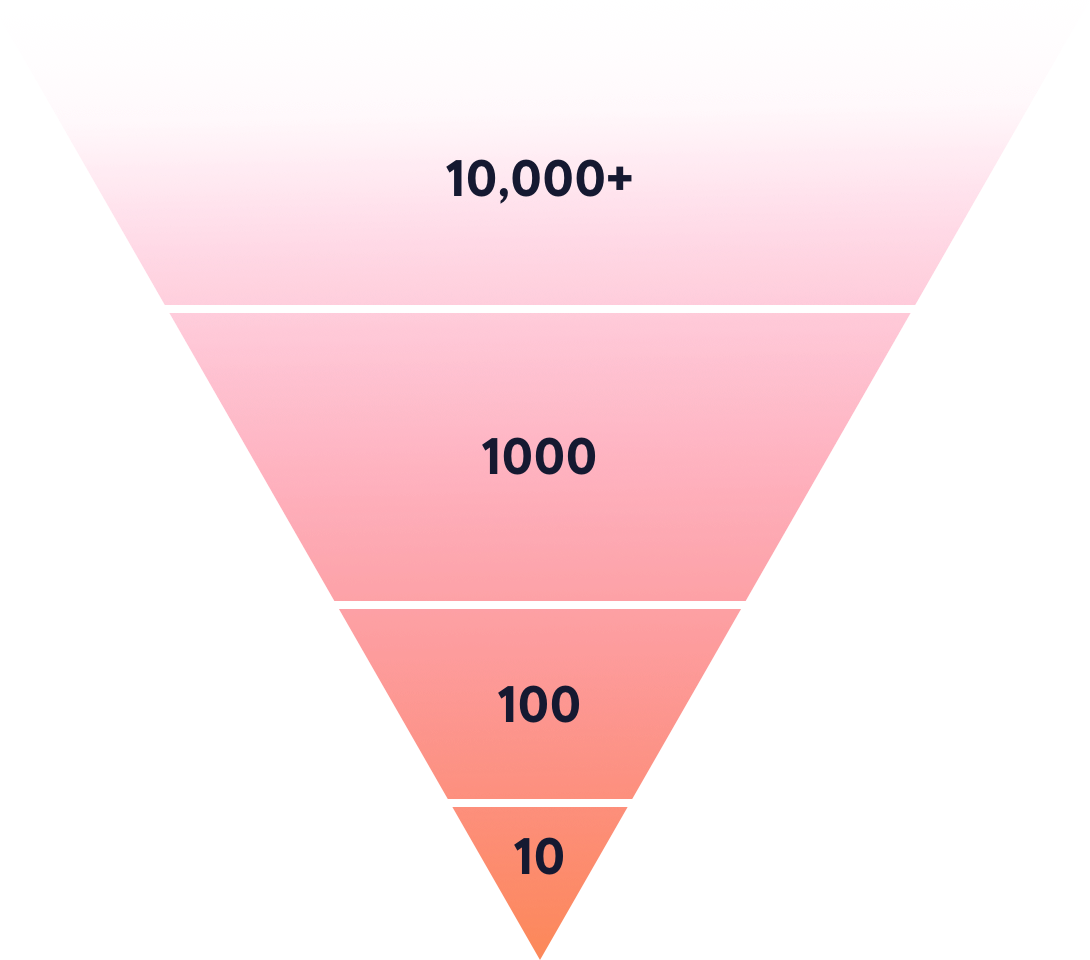When it comes to bringing a new digital product to market, it can seem like there is a pretty obvious path to launch.
It goes like this:
- Have a killer idea
- Assemble a team
- Build the product
- Launch to the masses
Great idea + great team + great effort at launch = MASSIVE SUCCESS, right?
Maybe not.
It’s easy to think a) that your idea is bulletproof – you’re so wrapped up in it, you lose all perspective of any possible problems and b) that showing your early efforts to anyone will be embarrassing, misleading and somehow invalidate its potential.
If only it was finished you’d understand it properly!
The temptation is to shut yourself away and fully build it out before a grand reveal when you’re ready to launch. We get it.
However, we believe that for the best chance of success, launch is best viewed as a process, not a date in the diary, and definitely not as the starting point for your product.
You’ve heard of 10x growth, where you aim for a future that is 10 times bigger than your current reality. A 10x launch is sort of the opposite.
We use it as a way to start with a tiny number of people and grow quickly to the point where launch is possible.
Launch is not the start – there’s so much to do before then..
We tend to use four phases, all of which can be summed up in a nice little diagram.

How to 10x it
From now on, ‘launch’ will always refer to the end of the 10x process. When you do launch to a potential large-scale customer base you’ll have a refined product that you know will engage and convert.
Before getting there you’ll be releasing iterations on your product to ever-growing numbers of people to iron out your biggest issues and assumptions.
By hitting early adopters first, you can put something you’re pretty embarrassed about in front of them and know that they’re less likely to disappear. Even if you lose your first 10 customers, who cares? There are plenty more fish in the sea.
The larger the numbers of people you release to, the more you’ll care about retaining them. You want a sticky product as soon as possible so as not to put off people you’ve put time and effort into onboarding.
This curve shows exactly what we mean:

So, what are the stages, you ask? Here they are with what you’ll be doing, who you need to speak to, how you’ll do it and what results you’ll expect.

10 People
Experiment 💡
What
You have an idea and want to know if it’s any good.
Who
People passionate about the idea. Early adopters.
How
- Face to face chats.
- Back of napkin sketches.
- Demos of very rough prototypes.
Results
- Enough learning to prove that there’s some traction with the idea.
- Detailed feedback on your concept.
- More understanding on who your initial persona is and their needs.
- Ideas for what might need to change.

100 People
Refinement 📝
What
Idea v2, time to go and find more people to test and refine the concept with a niche audience.
Who
A broader selection of early adopters. These people might have been recommended by your initial test users.
How
An early stage prototype or MVP. You could create some sort of Wizard of Oz MVP or can keep it as a simple no-tech demo that shows user flows through a proposed solution.
Results
- Detailed feedback on the solution.
- Commitment to sign ups.

1,000 People
Soft Launch 🚲
What
Things are getting more serious now. The idea has progressed enough to test with total strangers.
Who
You’ll probably be finding these using some sort of marketing spend, although this can be lightweight for now.
You’ll need to form a marketing strategy at this point and work out how you’ll be rating its performance.
How
Your true MVP.
A product that works, although may still have a limited feature set. This will most likely be the first iteration of the final product using a codebase you intend to build on for the long term. You’ll be observing user behaviour here, including the use of features, performance of onboarding funnels and whatever makes sense to track at this point.
It would never hurt to run dedicated user testing at this phase, either face to face or using online platforms to get detailed feedback.
Results
- Final revisions to the product based on analytical data.
- The creation of a post-launch backlog.
- Marketing analysis and launch plan.

10,000 People
Launch 🚀
This is it. You know enough now to push the product out to the public. You should be able to predict conversion rates based on marketing spend and have a clear picture for how and who you’re going to target.
You’ll have a backlog of tasks to work on but more will come up as greater numbers appear on the product. You’ll have a steering strategy in place and you’ll have a team in mind if not in place.
Hint: We know an agency who’re pretty hot at helping people move forward at this stage onto the 10x you’re familiar with, 10x growth! 😉
Idea to launch
Ready to disrupt your industry? We know how 💥
In Conclusion…
The key is that you shouldn’t be afraid to launch early and to almost no one. Better to learn early before you hit the 10,000 than learn nothing and hope.
Don’t start with launch.
Here’s to the next 10x! 🍾